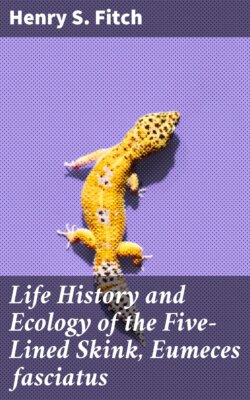Читать книгу Life History and Ecology of the Five-Lined Skink, Eumeces fasciatus - Henry S. Fitch - Страница 3
На сайте Литреса книга снята с продажи.
Introduction
ОглавлениеTable of Contents
The common five-lined skink (or common blue-tailed skink) is a small woodland lizard, abundantly and widely distributed over the eastern United States. Many authors have casually discussed this lizard or have treated in detail some phase of its biology. Excellent brief summaries of the known facts concerning its life history have been published by Smith (1946:349–350 and 1950:187–188) and Pope (1947:153–157). Nevertheless, no thoroughgoing study of its life history and ecology has heretofore been made.
In 1932, taxonomic studies by Dr. Edward H. Taylor revealed that the lizards previously referred to in the literature as Eumeces fasciatus, actually were three closely related and similar, partly sympatric species. Although Taylor’s work was careful and detailed, and indicated numerous minor differences by which the three species could be distinguished, many herpetologists were reluctant to accept his findings for nearly a decade thereafter. Consequently a large amount of literature concerning five-lined skinks is either obviously composite in the sense that it is based upon two or three species, or is not definitely assignable to any one species. In the study here reported upon, all pertinent literature available to me has been examined, and evaluated, and important findings of other authors have been incorporated in the discussion. However, mine was primarily a field study, and in one small part of the geographic range of the one species.
The University of Kansas Natural History Reservation is a tract of 590 acres preserved as a natural area, available for the pursuit of ecological studies. The studies undertaken include intensive investigations of selected species of vertebrate animals. The main criteria used in selecting these species have been whether or not they were sufficiently abundant and generally enough distributed to play an important role in the over-all ecology of the area, and whether a species was sufficiently accessible for study with available techniques. Among the 300 species of vertebrate animals recorded from the Reservation, the five-lined skink is one of those most frequently noticed in the field. In actual numbers it is probably exceeded only by the cricket frog (Acris gryllus), the leopard frog (Rana pipiens), the ring-necked snake (Diadophis punctatus), the prairie vole (Microtus ochrogaster) and perhaps the white-footed mouse (Peromyscus leucopus). Although numerous, the skink is not easy to study because it is secretive in its behavior, and is inactive in inaccessible shelters during the greater part of the year.
The five-lined skink generally occurs along with a characteristic set of community associates in a particular type of situation. It is a predator on various small animals, mostly invertebrates. For some of the many prey species the effect is certainly negligible, but for others its predation may be a major ecological factor. In areas where optimum habitat conditions exist its biomass may exceed that of any other insectivorous animal, and in such situations it assumes a major role as a predator and as a competitor with other insectivorous types. In turn it provides part of the food source of various larger predators, including reptiles, birds and mammals. It is a host and carrier of various parasites, including at least one species that regularly attacks humans—the common chigger. It is not evident on the basis of the present findings that the skink is either harmful or beneficial to any perceptible degree, in its over-all effect on human affairs and economy. Nevertheless, there probably are various unsuspected relationships.
In the course of my field study many workers on the University of Kansas Natural History Reservation helped by capturing skinks; especially Sydney Anderson, Richard Freiburg, John Hawken, Dennis G. Rainey and Lewis L. Sandidge. Mr. Robert Gordon very kindly furnished information on specimens in the Tulane University collection, which served as a basis for comparing the breeding schedule of the southern population with that of E. fasciatus in northeastern Kansas. Dr. W. J. Breckenridge kindly permitted examination of material in the University of Minnesota Museum of Natural History. Dr. Edward H. Taylor has made helpful suggestions from time to time. Mr. Richard B. Loomis helped me in various ways with the field work, and made available his personal field notes with records of predation on Eumeces by various snakes. Dr. E. Raymond Hall, Director of the Museum of Natural History, has critically examined the manuscript, and has been helpful in various ways. The line drawings and graphs, with the exception of Figures 8 and 9, were made or completed by Mrs. Louise Brunk, artist for the Museum.
The study here reported on was initiated in May 1949, and was continued through 1950, 1951 and 1952. A few observations made in 1948 have been included. Various separate items of information obtained in 1953 have likewise been incorporated especially where histories of individual skinks are presented, but the manuscript was completed in essentially its present form in the fall of 1952.
